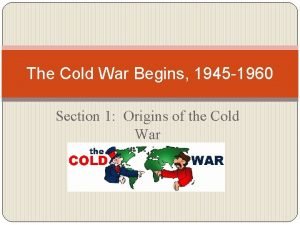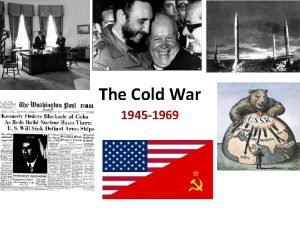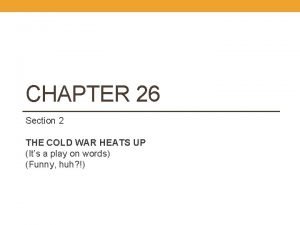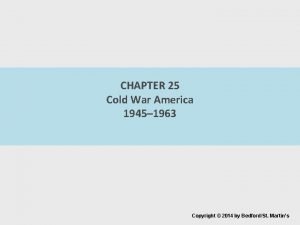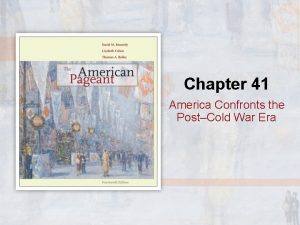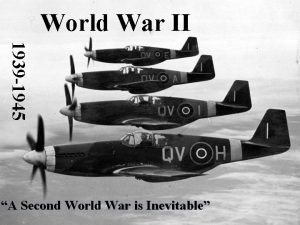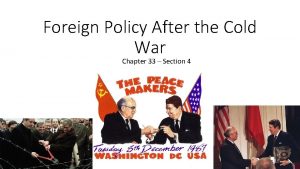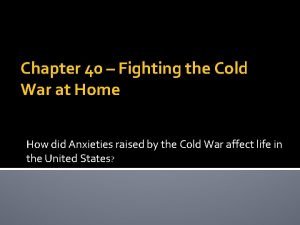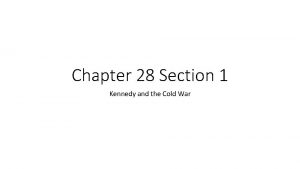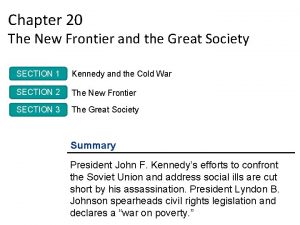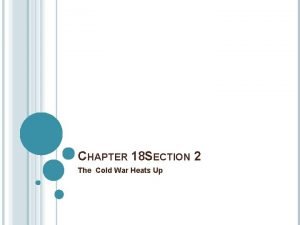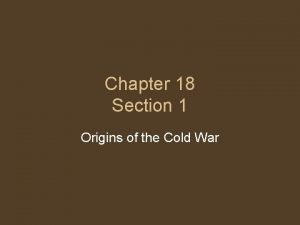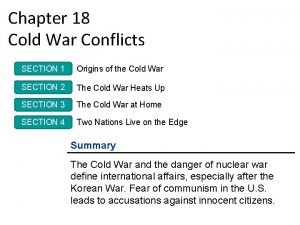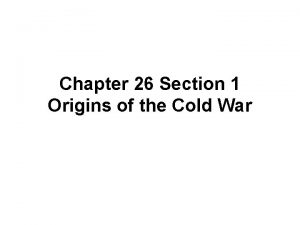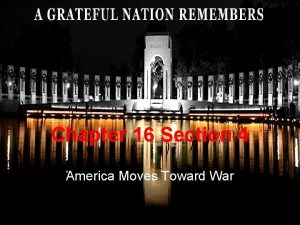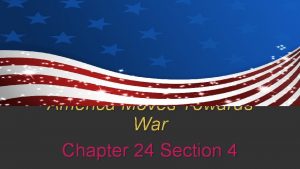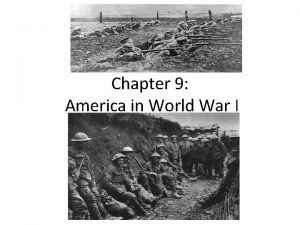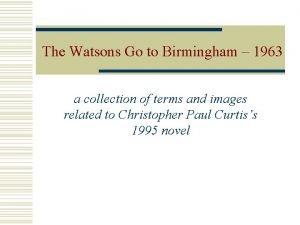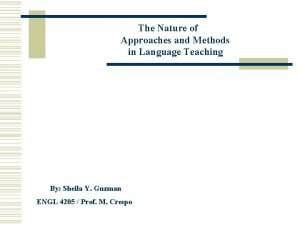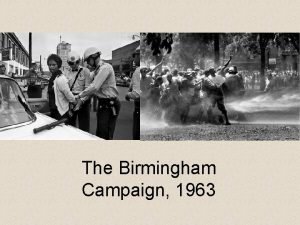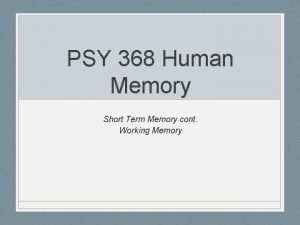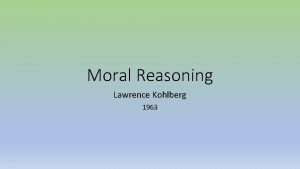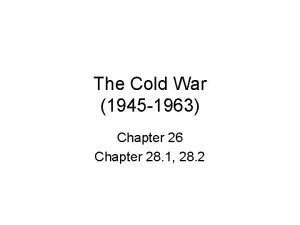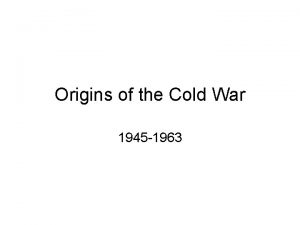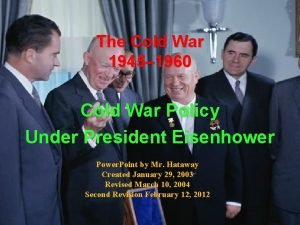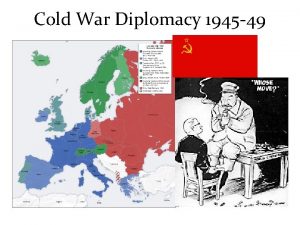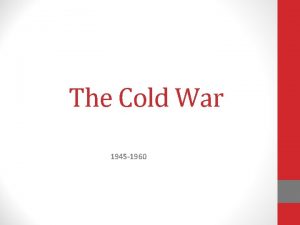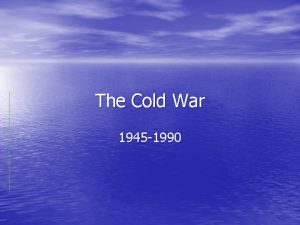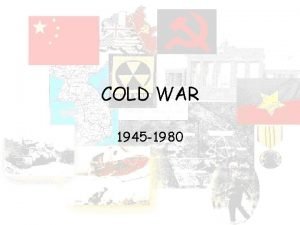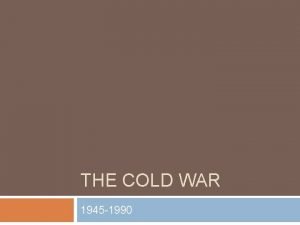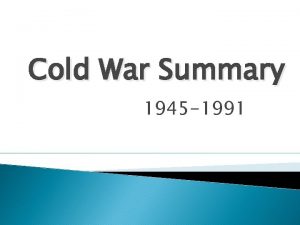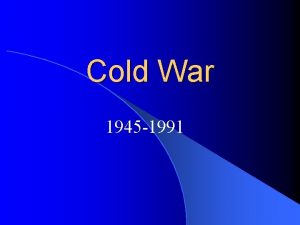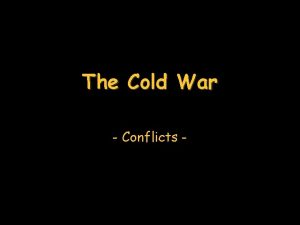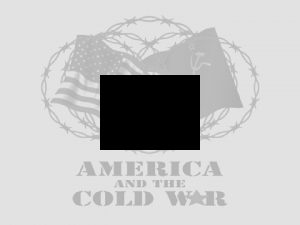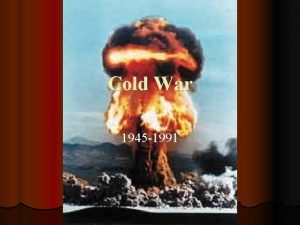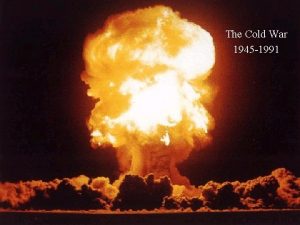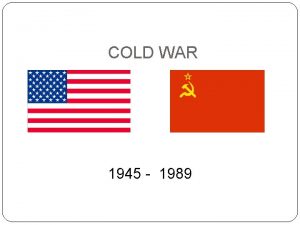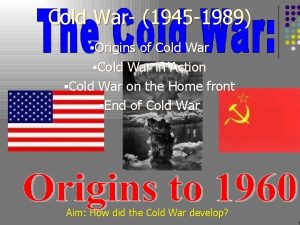CHAPTER 25 Cold War America 1945 1963 Copyright



































- Slides: 35

CHAPTER 25 Cold War America 1945– 1963 Copyright © 2014 by Bedford/St. Martin’s


I. Containment and a Divided Global Order A. Origins of the Cold War 1. Yalta - Big Three (Churchill, FDR, Stalin) met in February 1945, decided to create a United Nations with five nations (the three plus France and China) holding permanent seats on a Security Council; fates of nations of Eastern Europe divided the Big Three; FDR and Churchill agreed that Poland should be in the Soviet “sphere of influence” because of Stalin’s desire for a buffer between Germany; they agreed to “free” elections to be held in border nations. 2. Potsdam - Truman (who became president after Roosevelt’s death in April of 1945) immediately wanted to stand up to Stalin; unwilling to negotiate at the July 1945 Potsdam conference; free elections held in Finland, Hungary, Bulgaria, and Czechoslovakia, but not Poland or Romania (both occupied by the Red Army); to Americans, the failure of Stalin to hold elections in all of the border nations was the precipitating event of the Cold War; conflict over Germany led to agreements that paved the way for its division into East and West.



I. Containment and a Divided Global Order B. The Containment Strategy 1. Toward an Uneasy Peace - In February 1946, “Long Telegram” was sent by American diplomat George F. Kennan in Moscow: called for “long-term, patient but firm and vigilant containment of Russian expansive tendencies”; he believed that the Soviet system would eventually collapse if the U. S. and its allies opposed Soviet expansion in all parts of the world; Britain was in decline after the war, unable to aid their ant-icommunist ally Greece that was fighting a civil war; Truman Doctrine (military aid): March 1947 speech in which Truman asserted an American responsibility “to support free peoples who are resisting attempted subjugation by armed minorities or by outside pressures”; Truman proposed assistance for Greece and Turkey, which Congress approved; aid program for Western Europe was established, known as the Marshall Plan (economic aid) to help European nations recover from the war; restrictions kept Soviets from participating and intensified the Cold War.

I. Containment and a Divided Global Order B. The Containment Strategy(cont. ) 2. East and West in the New Europe - With no agreement for unification of Germany, the U. S. , Britain, and France consolidated their zones in 1947; after June 1948 Soviet blockade of West Berlin, American and British pilots began an “Berlin Airlift” of materials into the city. In April 1949, western nations began a collective security pact, the North Atlantic Treaty Organization (NATO). Under the NATO pact, twelve nations (U. S. , Canada, Britain, France, Italy, Belgium, Netherlands, Luxembourg, Denmark, Norway, Portugal, and Ireland) agreed that “an armed attack against one or more of them in Europe or North America shall be considered an attack against all of them. ” In 1949, those nations also agreed to creation of the Federal Republic of Germany (West Germany); in response, the Soviet Union created the German Democratic Republic and the Warsaw Pact (equivalent to NATO for Eastern Europe); continent was divided by East and West, with the East being cut off from the rest of the continent.



I. Containment and a Divided Global Order B. The Containment Strategy (cont. ) 3. NSC-68 - U. S. entertained the possibility of international control of nuclear technology but rejected it in order to maintain advantage over the Soviet Union; in September 1949, the Soviets detonated an atomic bomb; Truman then turned to the U. S. National Security Council (NSC), established by the National Security Act of 1947, for a strategic reassessment of U. S. security issues; in April 1950, the NSC delivered its report, known as NSC-68; the document marked a decisive turning point in the U. S. approach to the Cold War and encouraged development of a hydrogen bomb, as well as increased taxes to pay for dramatic increases in defense; many historians view the report as having “militarized” the American approach to the Cold War.


I. Containment and a Divided Global Order C. Containment in Asia 1. Civil War in China - Communist forces led by Mao Zedong challenged Nationalist forces under Jiang Jieshi; between 1945 and 1949, U. S. gave Jiang’s army $2 billion in aid to “save” China; in 1949, U. S. cut off aid, and Mao was victorious; Mao formed alliance with the Soviet Union; Truman’s State Department blamed for “losing” China. 2. The Korean War - At end of World War II, the U. S. and the Soviet Union jointly occupied Korean, divided at the 38 th parallel; Soviets supported Kim Il Sung in North Korea; the U. S. backed Syngman Rhee in South Korea; desire to reunify led to a northern military action; with the Security Council’s approval of a “peacekeeping force, ” Truman ordered U. S. troops to Korea; war began with a counterattack by the Chinese in 38 th parallelresponse to General Mac. Arthur sending troops across the; dispute with Mac. Arthur led to his dismissal; war dragged on for two years.





II. Cold War Liberalism (home front) A. Truman and the End of Reform 1. The 1948 Election -Truman had hoped for an expansion of the New Deal; Democratic Party was in disarray in 1948; left wing split off and formed Progressive Party, nominating Henry A. Wallace; the southern delegations left and called themselves Dixiecrats, protesting the party’s civil rights platform and supporting segregation; Republican Party nominated the politically moderate Gov. Thomas Dewey (R-NY); Truman won a surprise 49. 6 % of the vote to Dewey’s 45. 1 %. 2. The Fair Deal - In 1949, Truman proposed the Fair Deal: national health insurance, aid for education, a housing program, expansion of Social Security, a higher minimum wage, and a new agricultural program; Congress and the public were reluctant to support an enlarged welfare state; Truman’s proposal for national health insurance was denounced as “socialized medicine” by the American Medical Association and the insurance industry; in the end, the Fair Deal’s only major achievement, other than improvements to Social Security and the minimum wage, was the National Housing Act of 1949, which built 810, 000 low-income units.



II. Cold War Liberalism home front B. Red Scare: The Hunt for Communists 1. Loyalty-Security Program - Historians know today that there was significant penetration of the U. S. government by the Soviet Union during the 1930 s; they believe most had stopped by 1947; Truman believed he had to protect his administration against charges of espionage; he issued Executive Order 9835 (1947), which created the Loyalty-Security Program: permitted officials to investigate employees of the federal government for subversion; loose interpretation led to accusations; states began their own programs and began to require loyalty oaths for employees; labor unions were hit by charges of Communists within their ranks, as were the NAACP and the National Urban League. The Red Scare spread from the federal government to the furthers reaches of American organizational, economic, and cultural life.

II. Cold War Liberalism home front B. Red Scare: The Hunt for Communists(cont. ) 2. HUAC – The House Un-American Activities Committee (HUAC) was launched by Congressman Martin Dies of Texas and other conservatives in 1938; helped spark the Red Scare by holding widely publicized hearings in 1947 on alleged Communist infiltration in the movie industry; a group of writers and actors dubbed the Hollywood Ten were jailed for refusing to testify about past associations; the accused were “blacklisted”; Soviet archives tell us today that the Communist Party in the U. S. was taking money and instruction from the Soviet Union. 3. Mc. Carthyism - The career of Senator Joseph Mc. Carthy (DWI) marked both the apex and then the finale of the Red Scare; in February 1950, he claimed to have a “list” of known Communists working the State Department; waged a smear campaign against those who were “soft” on communism; in early 1954, Mc. Carthy overreached by launching an investigation into subversive activities in the U. S. Army with live hearings that were broadcast on TV; public support for Mc. Carthy’s tactics plummeted, and the Senate voted to censure him for unbecoming conduct in December 1954.


II. Cold War Liberalism home front C. The Politics of Cold War Liberalism 1. America Under Eisenhower - Nikita Khrushchev followed Stalin as leader of the Soviet Union (1956); called for “peaceful coexistence” with the West and denounced Stalin’s regime, but crushed Hungarian independence movement; the Dwight Eisenhower administration’s “New Look” or “M. A. D. ” (mutually assured destruction) defense policy increased production of the hydrogen bomb; Eisenhower was reluctant to criticize Mc. Carthy or to speak out on civil rights. 2. Democrats - Were strong in Congress but proved weak in presidential elections; largely agreed with Republicans on pressures of the Cold War and the demands of a modern, industrial economy.


III. Containment in the Postcolonial World A. The Cold War and Colonial Independence 1. Vietnam - Eisenhower was more concerned about anticommunism than stability in foreign governments; CIA was created in 1947; utilized secret operations and coups to combat communism. In August 1945, Vietnam declared independence from French; Ho Chi Minh led a Communist independence movement; Eisenhower feared a French failure to restore control (the so-called “domino theory”: communism spreading beyond Indochina); offered aid for French war against the Vietnamese; in early 1954, the French were defeated; the result was the 1954 Geneva Accords, which partitioned Vietnam at the 17 th parallel with reunification and elections to come in 1956. The U. S. rejected the Geneva Accords and used CIA to install a pro-U. S. government in South Vietnam Ngo Dinh Diem (a Chinese Catholic); reunification did not occur; U. S. began sending Diem approx. $200 million/year in aid plus military advisors.

III. Containment in the Postcolonial World A. The Cold War and Colonial Independence 2. The Middle East - Palestine, populated by Arabs, was believed to be the Jewish homeland; when British mandate in region ended, Zionists declared the state of Israel; Arab League invaded, but Israel survived; Palestinians were forced out of region and into refugee camps; President Truman recognized Israel as a new nation and won support from American Jewish voters. Egyptian independence was declared in 1952, led by Nasser who wanted to be neutral in Cold War; Nasser nationalized the Suez Canal; Britain, France, and Israel attacked Egypt and seized the canal; Eisenhower demanded they pull out of region; Nasser reclaimed the canal and used Soviet support to build the Aswan Dam on the Nile; in early 1957, concerned about Soviet influence in the Middle East, the president announced the Eisenhower Doctrine, which stated that American forces would assist any nation in the Middle East that required aid against “International Communism. ”



III. Containment in the Postcolonial World B. John F. Kennedy and the Cold War 1. The Election of 1960 and the “New Frontier” – Kennedy defeated Nixon in the campaign after four nationally televised debates swayed voters to his youthful, attractive candidacy; received 49. 7 percent of the popular vote to Nixon’s 49. 5 percent. 2. Crises in Cuba and Berlin -Kennedy half heartedly followed through on a CIA-supported Eisenhower plan to lead an uprising against Castro in Cuba; the April 1961 invasion at the Cuba’s Bay of Pigs failed; in June 1961, Khrushchev blockaded West Berlin; Kennedy responded by dispatching 40, 000 American troops to Western Europe; in August 1961, Communist government of East Germany built a wall (Berlin Wall) to stop easterners from fleeing to West Berlin; in October 1962, the Cuban Missile Crisis brought the U. S. closer to nuclear with the Soviets than ever before.




III. Containment in the Postcolonial World C. Making a Commitment in Vietnam 1. Supporting Diem - Kennedy tried to expand the role of U. S. Special Forces (“Green Berets”) in Vietnam where Diem’s opponents had formed the National Liberation Front (NLF) or Vietcong; Diem’s “strategic hamlet” program alienated peasants by moving them into barbed-wire compounds; persecuted Buddhists staged dramatic demonstrations and committed self-immolations to protest Diem’s regime; received worldwide outrage. 2. Chaos in South Vietnam -– In November 1963, Kennedy’s administration became increasingly frustrated with Diem (very unpopular with his people), but still supported his regime urging democratic reforms; Diem would not budge and was overthrown by military generals and assassinated by a CIA supported coup; South fell into chaos with a series of coups and no clear leadership; Kennedy was assassinated three weeks later.

III. Containment in the Postcolonial World home front 3. Kennedy and the World - Kennedy also launched a series of bold nonmilitary initiatives; one was the Peace Corps, which embodied a call to public service and was intended to provide the Third World (less developed countries) with an anti-communist alternative. Kennedy also championed space exploration, proposing to have a man on the moon within the decade; persuaded Congress to increase funding for the government’s space agency, the National Aeronautics and Space Administration (NASA), enabling the U. S. to pull ahead of the Soviet Union.

 The cold war begins lesson 1
The cold war begins lesson 1 The cold war begins 1945-1960
The cold war begins 1945-1960 The cold war heats up: 1945 - 1969
The cold war heats up: 1945 - 1969 Chapter 26 section 2: the cold war heats up answer key
Chapter 26 section 2: the cold war heats up answer key Chapter 25 cold war america
Chapter 25 cold war america America confronts the post-cold war era
America confronts the post-cold war era Cold war proxy
Cold war proxy 1945 world war ii
1945 world war ii 1945 world war
1945 world war Chapter 33 section 4 foreign policy after the cold war
Chapter 33 section 4 foreign policy after the cold war Chapter 17 cold war superpowers face off
Chapter 17 cold war superpowers face off Chapter 40 fighting the cold war at home
Chapter 40 fighting the cold war at home Section quiz chapter28 kennedy and the cold war
Section quiz chapter28 kennedy and the cold war Chapter 20 section 1 kennedy and the cold war
Chapter 20 section 1 kennedy and the cold war The cold war heats up chapter 18 section 2
The cold war heats up chapter 18 section 2 Chapter 18 section 1 origins of the cold war
Chapter 18 section 1 origins of the cold war Origins of the cold war chapter 18 section 1
Origins of the cold war chapter 18 section 1 Chapter 26 section 1 origins of the cold war
Chapter 26 section 1 origins of the cold war Chapter 16 section 4 america moves toward war
Chapter 16 section 4 america moves toward war Chapter 24 section 4 america moves toward war
Chapter 24 section 4 america moves toward war Chapter 9 america in world war 1
Chapter 9 america in world war 1 Chapter 30 the war to end war
Chapter 30 the war to end war Chapter 30 the war to end war
Chapter 30 the war to end war America america you mean the world to me
America america you mean the world to me North america south america europe asia
North america south america europe asia Whats an onomatopeia
Whats an onomatopeia Why called latin america
Why called latin america Eu amo a américa e a américa me ama
Eu amo a américa e a américa me ama Edward anthony 1963
Edward anthony 1963 Conk hairdo
Conk hairdo Edward anthony 1963
Edward anthony 1963 Birmingham campaign 1963
Birmingham campaign 1963 Georges braque le jour
Georges braque le jour Next in line effect psychology definition
Next in line effect psychology definition R v gill 1963
R v gill 1963 Kohlberg 1963
Kohlberg 1963

